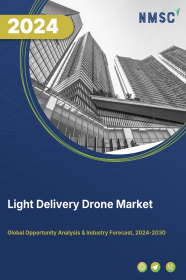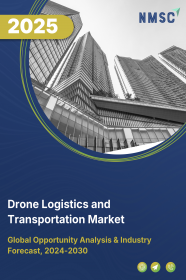
Light Delivery Drone Market by Type (Multi-rotor, Fixed-wing, and Hybrid Vertical Take-off and Landing Aircraft (VTOL), by Package Size (Less than 2 KG and 2-5 KG), by Range (Short range and Long Range), by Operation Mode (Remotely piloted, Partially-autonomous, and Fully autonomous), and by End-use (Logistics, Healthcare, Pharmaceutical, Food and beverage, Retail, E-commerce, and Others)- Global Opportunity Analysis and Industry Forecast 2024-2030
US Tariff Impact on Light Delivery Drone Market
Trump Tariffs Are Reshaping Global Business
Market Definition
The global Light Delivery Drone Market size was valued at USD 1.6 billion in 2023 and is predicted to reach USD 23.7 billion by 2030 with a CAGR of 42.7% from 2024-2030. Light delivery drones are unmanned aerial vehicles (UAVs) designed to deliver goods from a warehouse or store to a customer’s doorstep. They are generally smaller and lighter than other types of delivery drones and are typically equipped with sensors and cameras to help them navigate and avoid obstacles.
Lightweight delivery drones can carry items such as packages, mail, food, and medical supplies up to several kilograms and fly autonomously. They use pre-programmed routes or remote-controlled navigation to deliver packages to remote or hard-to-reach locations such as inaccessible communities, rural areas, and emergency or disaster-stricken areas.
Light delivery drones can dramatically reduce delivery times, reduce costs, and increase customer satisfaction. Delivery drones can also be used for aerial photography and surveying, as well as for search and rescue operations.
Market Dynamics and Trends
The rapid expansion of e-commerce, healthcare, and food & beverage industries, coupled with the increasing prevalence of online shopping, is fueling the growth of the light delivery drone market. This surge in demand is driven by the need for efficient and timely delivery solutions to meet the rising consumer expectations for fast and convenient deliveries.
For instance, there were 500,000 commercial drone deliveries conducted in the first half of 2023, highlighting the growing reliance on unmanned aerial vehicles to facilitate last-mile delivery operations. As businesses strive to optimize their delivery processes and enhance customer satisfaction, the use of light delivery drones is anticipated to grow at a rapid rate in the forecasted years.
Moreover, advancements in technologies such as vertical take-off and landing aircraft (VTOL), geospatial mapping, Internet of Things (IoT), and machine learning are propelling the growth of the light delivery drone market. These innovations are revolutionizing the capabilities and functionalities of drones, making them more versatile and efficient for various applications.
For instance, in April 2022, TechEagle launched the Vertiplane X3 drone, which features hybrid e-VTOL capabilities. This drone combines the vertical take-off and landing abilities of a helicopter with the aerodynamic features of an airplane, allowing the drone to take off and land vertically while offering enhanced maneuverability and flexibility in various operational environments.
However, the high cost of delivery drones and the risk to public safety and security are the major factors restraining the growth of the market. On the contrary, technological advancements such as autonomous drone flight and the introduction of sodium-ion batteries for longer flight times are expected to create ample opportunities for the light delivery drone market in the coming years.
Market Segmentations and Scope of the Study
The light delivery drone market share is segmented based on type, package size, range, operation mode, end-users, and region. Based on type, the market is divided into multi-rotor, fixed-wing, and hybrid vertical take-off and landing aircraft (VTOL).
Based on package size, the market is classified into less than 2 kg and 2-5 kg. Based on range, the market is divided into short-range and long-range. Based on operation mode, the market is segmented into remotely piloted, partially autonomous, and fully autonomous.
Based on end-users, the market is classified into logistics, healthcare, pharmaceutical, food and beverage, retail, e-commerce, and others. Regional breakdown and analysis of each of the aforesaid segments include regions comprising North America, Europe, Asia-Pacific, and RoW.
Geographical Analysis
Asia Pacific holds the dominant share of the light delivery drone market today, and is expected to continue its dominance during the forecast period. This is attributed to factors such as the rapid expansion of the e-commerce industry and the escalating adoption of light delivery drones across the region.
Recently in 2023, Asia Pacific accounted for 43% of global drone deliveries, highlighting the significant role of the region in driving the overall market growth. As e-commerce continues to flourish and consumer demand for fast and efficient delivery solutions rises, the utilization of light delivery drones is expected to increase further, fueling market expansion in the Asia Pacific region.
Moreover, the increasing collaboration among major companies such as Wingcopter GmbH and Rakuten Group Inc. to develop and utilize delivery drones across various sectors, including logistics and healthcare in challenging terrains, is driving the growth of the market.
For instance, in April 2021, Wingcopter partnered with ANA Holdings Inc., to expedite the deployment of drones for transporting essential drugs and consumer goods to Japan's remote islands and mountainous regions to improve access to critical supplies in hard-to-reach areas.
As more companies join forces to leverage drone technology for diverse applications, the market for delivery drones is expected to continue expanding, offering innovative solutions for transportation and delivery in challenging environments.
On the other hand, the North American region is projected to experience a consistent upward trajectory in the light delivery drone market. This growth is driven by several factors, including the increasing use of long distance delivery drones by major e-commerce companies in the North American region.
In 2022, Walmart collaborated with four drone delivery firms DroneUp, Flytrex, Zipline, and most recently Wing, and designated 36 stores as drone delivery hubs across seven US states. This strategic partnership was aimed at enhancing logistics operations and meeting the growing demand for efficient and timely deliveries in this region.
Moreover, the presence of key market players such as Amazon Inc. and Matternet Inc. significantly influences the development of the light delivery drone market in this region. As these key players continue to innovate and collaborate, they contribute to the advancement and expansion of the light delivery drone market, driving its growth and adoption across various industries.
For instance, in August 2021, Matternet partnered with UPS' drone delivery service, UPS Flight Forward (UPSFF), and iQ Healthtech Labs based in Winston-Salem to utilize Matternet's M2 drone. This collaboration was aimed to enhance the efficiency of medication delivery services and streamline the collection of blood and urine samples from patients.
Competitive Landscape
Various market players operating in the light delivery drone industry include Amazon.com Inc., Boeing Co., Airbus SE, Drone Delivery Canada Corp, Wing Aviation LLC, Flirtey, Zipline, Wingcopter GmbH, Manna Drone Delivery, Flytrex Inc. and others. These market players are adopting various strategies such as product launches and collaborations.
For instance, in November 2022, Amazon launched a new delivery drone MK-30. The new drone is compact, quieter, capable of flying in light rain, increased range, and greater tolerance to extreme heat.
Also, in March 2022, EHang partnered with Aerotree Flight Services Sdn. Bhd. to jointly develop urban air mobility (UAM) business in Malaysia, including MRO and training. As part of the agreement, AEROTREE has placed a pre-order for 50 EHang EH216 series planes and 10 VT-30 planes.
Furthermore, in February 2022, Wing Aviation LLC collaborated with Kentucky Fried Chicken (KFC) to transport a variety of hot and fresh menu items directly to Logan, Queensland homes and offices using the delivery drone.
Key Benefits
-
The report provides quantitative analysis and estimations of the light delivery drone market from 2024 to 2030, which assists in identifying the prevailing market opportunities.
-
The study comprises a deep-dive analysis of the current and future light delivery drone market trends to depict prevalent investment pockets in the market.
-
Information related to key drivers, restraints, and opportunities and their impact on the light delivery drone market is provided in the report.
-
A competitive analysis of the players, along with their market share is provided in the report.
-
SWOT analysis and Porter's Five Forces model are elaborated in the study.
-
Value chain analysis in the market study provides a clear picture of the roles of stakeholders.
Light Delivery Drones Market Key Segments
By Type
-
Multi-Rotor
-
Fixed-Wing
-
Hybrid Vertical Take-Off and Landing Aircraft (VTOL)
By Package Size
-
Less Than 2 Kg
-
2-5 Kg
By Range
-
Short Range
-
Long Range
By Operation Mode
-
Remotely Piloted
-
Partially Autonomous
-
Fully Autonomous
By End-Use
-
Logistics
-
Healthcare
-
Pharmaceutical
-
Food and Beverage
-
Retail
-
E-Commerce
-
Others
By Region
-
North America
-
U.S
-
Canada
-
Mexico
-
-
Europe
-
UK
-
Germany
-
France
-
Italy
-
Spain
-
Denmark
-
Netherlands
-
Finland
-
Sweden
-
Norway
-
Russia
-
Rest of Europe
-
-
Asia-Pacific
-
China
-
Japan
-
India
-
South Korea
-
Australia
-
Indonesia
-
Singapore
-
Taiwan
-
Thailand
-
Rest of Asia-Pacific
-
-
RoW
-
Latin America
-
Middle East
-
Africa
-
REPORT SCOPE AND SEGMENTATION:
|
Parameters |
Details |
|
Market Size in 2023 |
USD 1.6 billion |
|
Revenue Forecast in 2030 |
USD 23.7 billion |
|
Growth Rate |
CAGR of 42.7% from 2024 to 2030 |
|
Analysis Period |
2023–2030 |
|
Base Year Considered |
2023 |
|
Forecast Period |
2024–2030 |
|
Market Size Estimation |
Billion (USD) |
|
Growth Factors |
|
|
Countries Covered |
28 |
|
Companies Profiled |
15 |
|
Market Share |
Available for 10 companies |
|
Customization Scope |
Free customization (equivalent up to 80 working hours of analysts) after purchase. Addition or alteration to country, regional, and segment scope. |
|
Pricing and Purchase Options |
Avail customized purchase options to meet your exact research needs. |
KEY PLAYERS
-
Amazon.com Inc.
-
Boeing Co.
-
Airbus SE
-
Drone Delivery Canada Corp
-
Wing Aviation LLC
-
Flirtey
-
Zipline
-
Wingcopter GmbH
-
Manna Drone Delivery
-
Flytrex Inc.

















 Speak to Our Analyst
Speak to Our Analyst

















